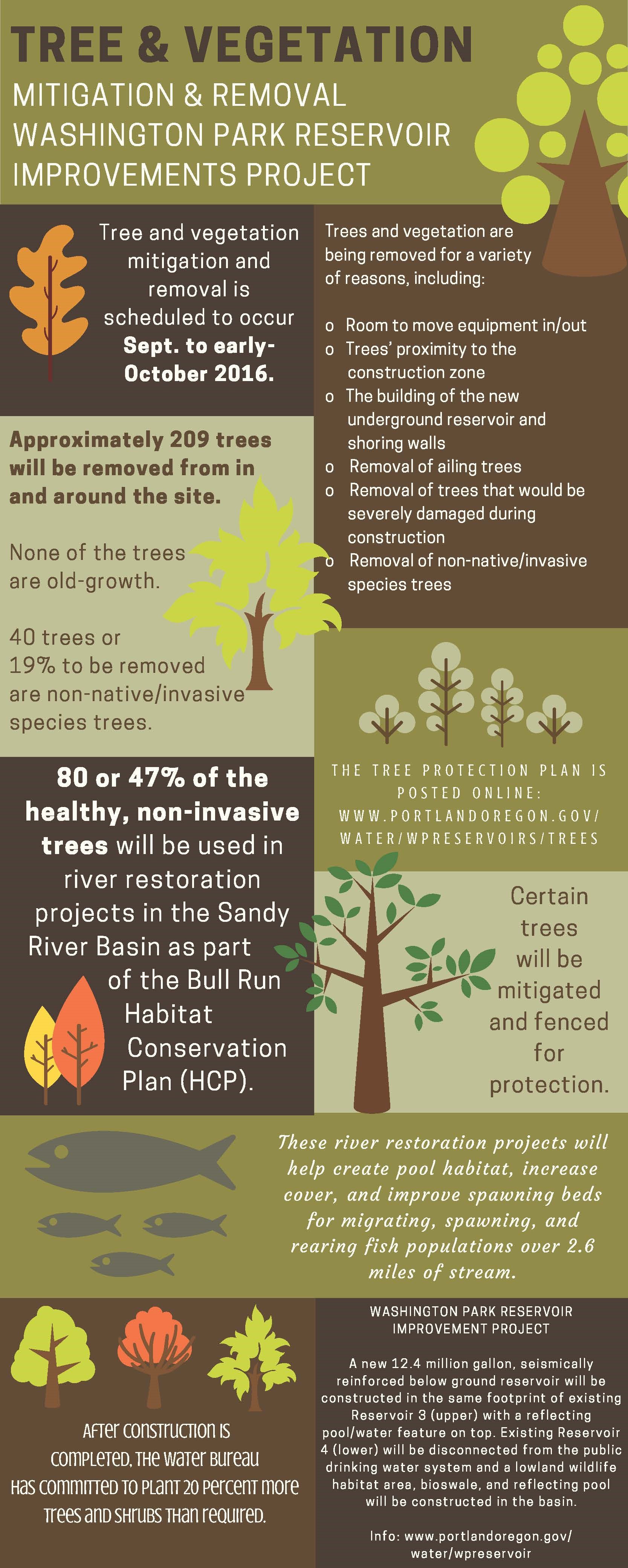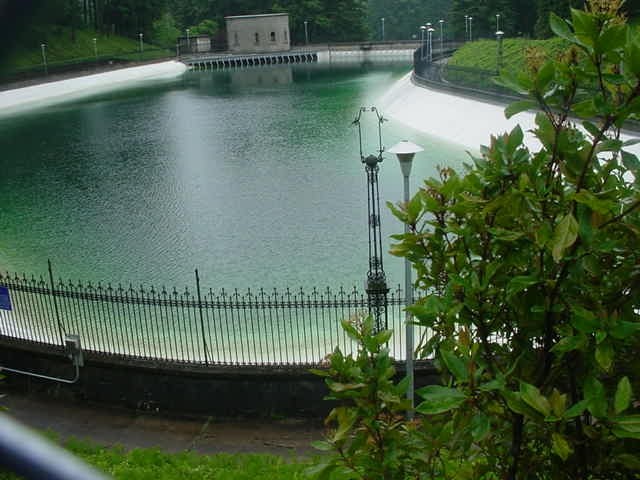The Portland Water Bureau and contractor Hoffman Construction Company have begun a capital improvement project to update the Washington Park reservoir site at 2403 SW Jefferson Street. The project complies with federal and state mandates, seismically strengthens key water infrastructure on Portland’s west side, and helps ensure a healthy, resilient, and secure water system.
The project includes building a new 12.4 million gallon, seismically reinforced, below ground reservoir with a reflecting pool/water feature on top. The new reservoir will preserve the historic drinking water function provided by the original reservoirs and be engineered to withstand ongoing landslide encroachment and potentially catastrophic effects of a major earthquake. Existing Reservoir 4 will be disconnected from the public drinking water system and a lowland wildlife habitat area, bioswale, and reflecting pool will be constructed in the basin.
WA Park Reservoir May 2017 (PDF)
AT-A-GLANCE
Attached is the monthly project update for May 2017.
- See Page 1 for information about the Rose Garden ADA project.
- See Page 2 for information on the Explore Washington Park Shuttle.
- See Page 2 for updated project work information.
Access a map of park impacts spanning mid-September 2016 to March 2018 online at: www.portlandoregon.gov/water/wpreservoirs/maps.
KEEPING YOU UP-TO-DATE
The next update is scheduled to be e-mailed in late June 2017. Please contact us with questions, concerns, or to change your project update preferences.
- Reach us by Phone: 503-823-7030
- Write us an E-mail: sam@jla.us.com
- Visit us Online: www.portlandoregon.gov/water/wpreservoirs
Thank you for your cooperation and understanding during this important capital improvement project. As always, we strive to provide quick responses to your concerns, minimal disruption near your residence or business, and open and clear communication with you throughout the project.
MAY 2017 ACCOMPLISHMENTS
General Site Work
- Onsite haul road for soil delivery from Reservoir 3 to Reservoir 4– preparation of the onsite haul road is reaching completion. The haul road will expedite the earth moving by reducing material handling, and eliminate potential maintenance shutdowns and work loss.
- Filling Reservoir 4 – Contractors have continued placing subsurface drainage material in Reservoir 4. Excavated material from Reservoir 3 is being placed on top of the subsurface drainage layer. As part of the project, existing Reservoir 4 will be buried, making room for a large wetland and wildlife habitat area with open water and connecting walkways.
- Work inside Gatehouse 4 – Drainage/sump construction at the bottom of the gatehouse.
UPCOMING/ONGOING WORK
- Erosion control at the site is ongoing.
- Shoring wall construction along Sacajawea will continue. Two shoring walls will be constructed – one temporary and one permanent – to protect the site from earth movement and allow for construction of the underground reservoir. The temporary shoring wall is nearing completion. Construction of the permanent shoring wall will begin in about 2 months.
- Work inside Gatehouse 4 – Continue construction of sump and piping at the bottom of the gatehouse and other improvements.
SAFETY IS OUR TOP PRIORITY
The traffic plan spanning now until March 2018 has been approved by the Portland Bureau of Transportation. The Water Bureau will be conducting evaluations and adjusting traffic flow as conditions require. The Water Bureau is working with Portland Parks & Recreation, Explore Washington Park, neighborhood associations, and the community to gather on-the-ground feedback and determine if changes are necessary. Please provide your traffic and signage feedback by phone, e-mail, or on the dedicated webpage.
Please see below or visit us online and click on Tree & Vegetation Mitigation & Removal.
Tree and vegetation mitigation and removal is scheduled to occur Sept to early-Oct. 2016.
Trees and vegetation are being removed for a variety of reasons, including:
- Room to move equipment in/out of project site
- Trees’ proximity to the construction zone
- The building of the new underground reservoir and shoring walls
- Removal of ailing trees
- Removal of trees that would be severely damaged during construction
- Removal of non-native/invasive species trees
The Tree Protection, Preservation, and Removal Plan is posted online.
Approximately 209 trees will be removed from in and around the site.
- None of the trees are old-growth
- 40 trees (19 percent) to be removed are non-native/invasive species trees
- 80 (47 percent) of the healthy, non-invasive trees will be used in river restoration projects in the Sandy River Basin as part of the Bull Run Habitat Conservation Plan (HCP). These projects will help create pool habitat, increase cover, and improve spawning beds for migrating, spawning, and rearing fish populations over 2.6 miles of stream.
Certain trees will be mitigated and fenced for protection.
Some of the tree’s root balls within the project limit will be left in the soil for stability.
After construction is completed, the Water Bureau has committed to plant 20 percent more trees and shrubs than required.
More About the Project
A new 12.4 million gallon, seismically reinforced below ground reservoir will be constructed in the same footprint of existing Reservoir 3 (upper) with a reflecting pool/water feature on top. The new reservoir will preserve the historic drinking water function provided by the original reservoirs and be engineered to withstand ongoing landslide encroachment and potentially catastrophic effects of a major earthquake.
When complete and online, the new reservoir will supply water to Portland’s west side and serve more than 360,000 people, including all downtown businesses and residents, 20 schools, three hospital complexes, more than 60 parks, and the Oregon Zoo.
Existing Reservoir 4 (lower) will be disconnected from the public drinking water system and a lowland wildlife habitat area, bioswale, and reflecting pool will be constructed in the basin.
Construction has started and will proceed through 2020. A pause in construction is scheduled to occur from 2020 to 2022 to allow soils to settle. From 2022 to 2024, construction of interpretive features, including the two reflecting pools and surface features, will conclude the project.

